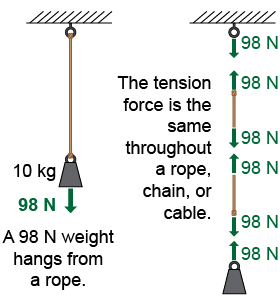|
Some elements of structures are made with rigid materials, such as concrete, wood, glass, or metal. Rigid materials can withstand compression and shear forces. Other elements of structures are flexible, such as ropes, cables, or chains. Flexible elements can support only tension forces, but they offer the advantages of being light and allowing parts of a structure to move. 
|

|
 The force from a cable, rope, or chain lies along the direction of its length and is a tension force. There are no reaction forces at the attachment point other than the tension force. The tension force transmitted by a “perfectly frictionless” rope is the same everywhere along the rope. For example, if you were to cut a rope and hold the cut ends you would feel the same tension force on either hand. Ropes cannot transmit compression or sideways forces! Wherever a rope (or cable or chain) is connected, you may assume the tension force on the connection points away from the connection, along the rope. Ropes only have tension if a force is applied at both ends, such as during a game of “tug-of-war.”
The force from a cable, rope, or chain lies along the direction of its length and is a tension force. There are no reaction forces at the attachment point other than the tension force. The tension force transmitted by a “perfectly frictionless” rope is the same everywhere along the rope. For example, if you were to cut a rope and hold the cut ends you would feel the same tension force on either hand. Ropes cannot transmit compression or sideways forces! Wherever a rope (or cable or chain) is connected, you may assume the tension force on the connection points away from the connection, along the rope. Ropes only have tension if a force is applied at both ends, such as during a game of “tug-of-war.” 
 |
These rules apply to massless or idealized ropes. In reality, ropes, chains, and cables have some mass. A rope that is hanging from one end will exert a tension at the attached end that is caused by the rope's mass pulling down on the rope. In introductory physics textbooks, however, you can usually assume that ropes are massless! 
|
Another common structural element is a beam. A beam can transmit both compression and tension forces. A vertical beam is often called a post. Posts and beams can be connected in different ways and the forces they transmit depend on how they are connected. “Post-and-beam” timber framing is a style of house construction that has been used for many centuries. 
|

|
A link is a section of a beam or post that has pinned connections at both ends. Very strong, lightweight structures called trusses are made from links. A link can transmit either a tension or a compression force along its length. Where two links either join or meet a wall, each exerts a force on the other in the direction of the connecting link. 
|
| |
|

